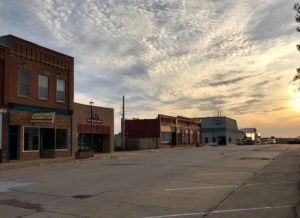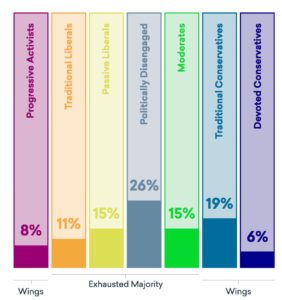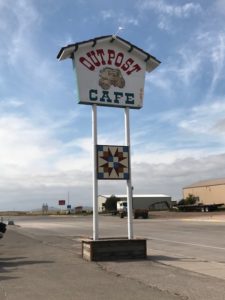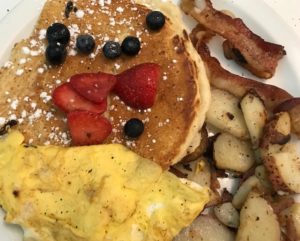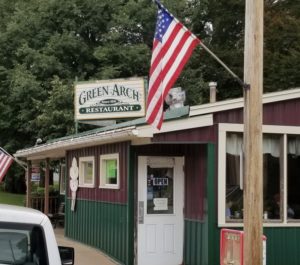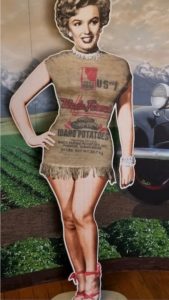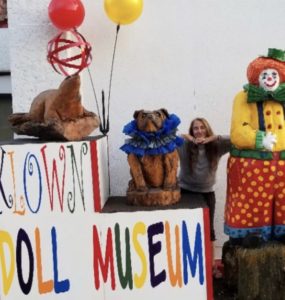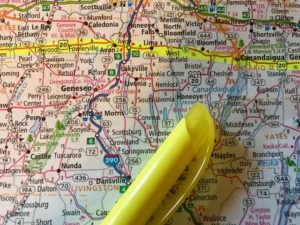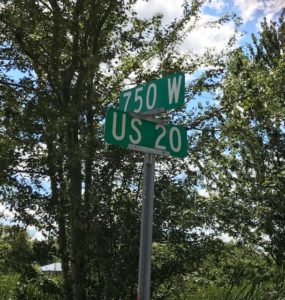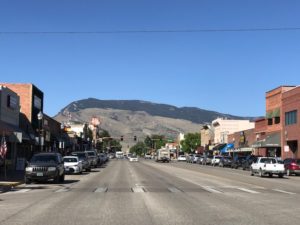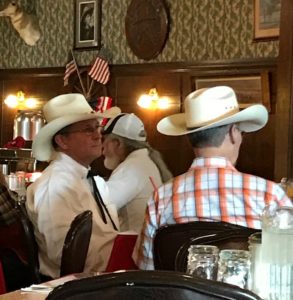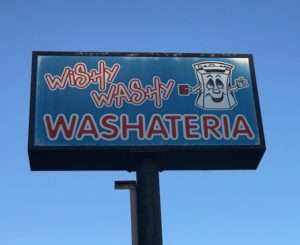Category — Travel
America the Beautiful
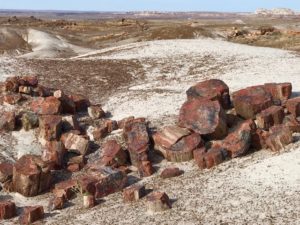 It is such a pleasure, such a relief (and yes, I know, such a privilege) to be enveloped by warm feelings about my country. I don’t, of course, mean the current government. I don’t, of course, mean the heart-stopping (sometimes literally) inequities, the deep and damaging social issues that ruin lives and erode spirits.
It is such a pleasure, such a relief (and yes, I know, such a privilege) to be enveloped by warm feelings about my country. I don’t, of course, mean the current government. I don’t, of course, mean the heart-stopping (sometimes literally) inequities, the deep and damaging social issues that ruin lives and erode spirits.
I mean the geography. I mean the Petrified Forest with its mineralized, crystalline logs—blue, green, pink, orange—part of a striking desert landscape that used to be lush tropics. That was millions of years ago when all the continents were one land mass, Pangea, when Arizona was where Costa Rica is today. I mean the otherworldly formations of blue-gray bentonite clay, striated hillocks and mesas with eroded surfaces that look like elephant skin. I mean escarpments that rise from the flat scrublands and extend for miles. Rock outcroppings, arches, table-tops, cairns, canyons and cliffs. I mean pinon forests, juniper, Ponderosa pine. I mean 9,000-foot mountain passes and 12,000-foot mountains.
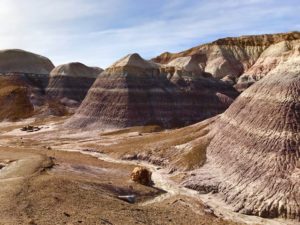
And I also mean the richness of cultures that live in these places: the silver-and-turquoise-jeweled arty types walking the streets of Santa Fe, the motorcycle-riding day drinkers in Madrid (pronounced MAY-drid), the New Agers soaking in Giggling Springs up at Jemez, the pick-up driving cowboys of Gallup—white, Hispanic, Native—in their straw hats and billed caps, the families—Native and Hispanic, the old people with their faces etched by sun and wind sitting beside grandchildren, great grandchildren.
This is the land that used to be Mexico. This is the land that used to be Navajo and Hopi, Zuni and Apache. And “we”—the U.S.A. of the 18th and 19th and 20th centuries—took it by force, by disease, by deceit, by political maneuverings. That is our history. That is our shame.
But it is also true that when you drive through this country, hike it, walk its main streets, eat at its diners, you can see how deeply and permanently embedded our diversity really is. The Navajo are here, 65,000 people strong. Almost fifty percent of New Mexicans are either descendants of Spanish colonists or recent immigrants from Hispanic America. For just a moment, let’s not talk about poverty here. Let’s revel in the beauty of geographic, cultural and racial diversity. There is a deep pleasure in experiencing it, in walking through it. Land and people.
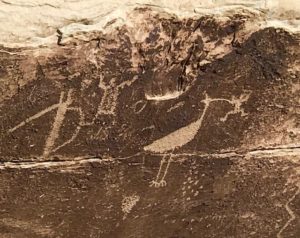
March 13, 2019 2 Comments
Solstice. Full Moon
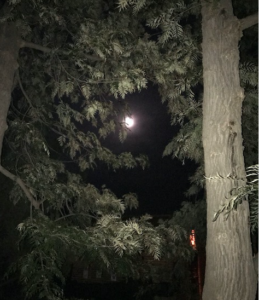
This is a photograph I took of the full moon on solstice eve. Photographers say, “an image I made” not “took,” and I like this much better. I think it more accurately reflects the art involved—but does it sound pretentious? To hell with that.
I wanted to use this image I made as the centerpiece of today’s post for a few reasons:
>I like it. It is ghostly and mysterious but not scary. It feels otherworldly to me, yet it is very much of this world.
>It was taken while walking with new friends, two intensely creative, enormously accomplished but down-to-earth-humble couples I met while conducting a workshop in Mexico. We bonded the first night we met in that I’ve-known-you-forever way that seldom happens. They are funny and kind and fascinating and we got each other’s cultural references. Will we see each other again? I have no idea. One couple—cinematographers—live in Hawaii; the other—jazz musicians—live in Wisconsin. I hope our paths cross again, but even if they don’t, this won’t diminish the power and intensity of that instant friendship.
>I have unsuccessfully pointed my iPhone to the night skies many times, hoping to capture moon, stars, back-lit clouds. (With my “real” camera I would be more successful, but the best camera is the one you have at the moment, as they say.) Sending a flash out into the sky rarely works. This time, I let the camera’s light bounce off a nearby tree, wondering what would happen. This happened. And I am taking a life lesson from it. Focusing on the close-by can illuminate the far-away. (Which, now that I think of it, is just another way of saying “the small story that illuminates the larger theme”…the approach that underlies my writing life. Ha. How about that?)
>Solstice. Full moon. Isn’t that enough by itself?
December 26, 2018 1 Comment
That Place
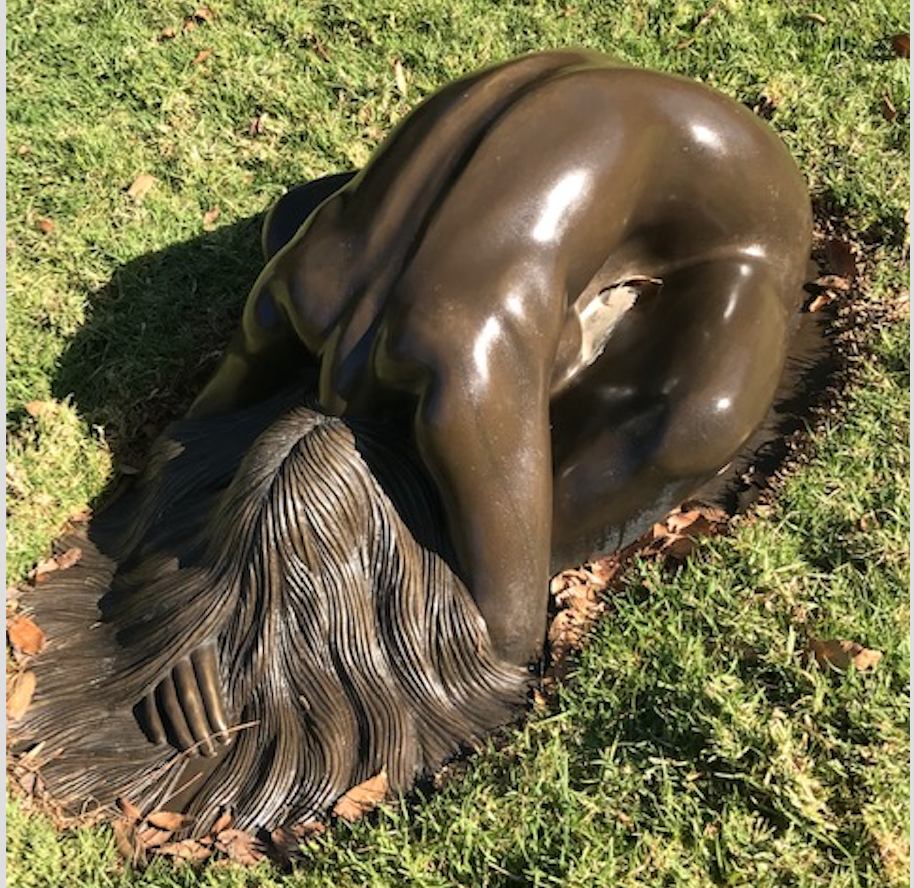
Have you ever been in a place that feels totally, gloriously, vibrantly female? A place that immediately attunes to some inner vibration? A place that it makes your body sing? And you didn’t even know your body could sing. A place where you so effortless fit in that it makes you realize how much effort it has taken to fit in all those other places that are not this way, places where you have lived and worked, walked through, visited,places where you had to either figure out how to accommodate yourself, how to not be too conspicuously who you were (that is: female) or places where you had to be careful, be on high alert, watch yourself. This is a place that hugs you with a full-body hug. A warm, soft female body.
This is the place I find myself right now, and I am all but overcome with the privilege of being here. This place, south of San Diego just across the Mexican border, was founded almost 80 years ago by a Hungarian-born philosopher and health “cultist” and his Brooklyn-born acolyte wife—who after the professor’s death 40-plus years ago, dreamed a much bigger dream, took charge of this place, and while re-making it, re-made herself into a powerful (and ageless) business woman.
For the past 30 years, this place has been re-imaged, nurtured (literally by hand) and built stone by stone, plant by plant by that woman’s daughter. She, the daughter, has designed most of the landscapes throughout the 32 lush acres of gardens. She has done this with grace and intention, with both an aesthetic and environmental consciousness, and with deeply feminine energy. The trick has been to create, out of earth, stone, and plants, a cultural, horticultural, and personal statement—a living expression—and make it feel as if it has always been here. And make it feel like you belong here.
It is the winding pathways that meander past little meadows and gnarled grape vines, across small wooden bridges, under arches, around boulders that sprout succulents from their cracks. It is the hidden benches,the pergolas, the smell of lavender and rosemary and sage. It is the gift of a tiny bottle of rose neroli oil left on your doorstep. It is this statue, my favorite of many on the property: her strong back, her luxuriant hair, how unassumingly, fearlessly she rests in child’s pose, how she glistens in the sun.
Thank you, Deborah Szekely. Thank you, Sarah Livia Brightwood.
December 19, 2018 No Comments
Route 20 Report #7
It’s been one month since we returned from our Route 20 cross-country “rediscover America” trip that took us Pacific to Atlantic on the only remaining unbroken non-freeway road that traverses the country. I’m still sorting through what I learned. I thought there would be an ah-ha moment as we explored the 3000-plus miles between the coasts. I was looking for insights into how we, post 2016, find ourselves in a country so deeply divided, so unsettlingly, unremittingly nasty, so angry and hateful to each other and to the rest of the world. I thought I’d find answers on this journey through the heartland.
What I found was prosaic, not revelatory, Or maybe, because it was prosaic, it was revelatory: People value their families. People love their communities. People work hard. People trust more than they fear. People respond to kindness with kindness. People generally like to be left alone to live their lives.
The divisions I was looking for, the divisions I thought I knew all about after two years of staring at Red State/ Blue State maps, after reading endless post-electoral musings about The Coasts v The Interior, were not the divisions I found.
What I found, instead, were overarching commonalities that have been obscured by hate-mongering from on high. What I found were friendly people. What I found was more diversity, more tolerance than I ever imagined. I am thinking about the gay Latino baker who sold pastries in an alcove of a Grange hall as he chatted with VFW guys in camo hats. That should be the image we see. Meme that.
This morning I awoke – and I mean that both literally and in the vernacular — to read David Brooks’ op-ed, in the New York Times based on this eye-opening recent report about who we really are, Hidden Tribes. The deep, searing divide that I thought of as Our Country is really just at the edges and represents less than 15 percent of us. It is the divide between the “progressive activists” and the “devoted conservatives.” It is, as Brooks’ calls it, “The Rich White Civil War.”
Here’s a bit of what the report reveals: 90 percent of devoted conservatives think immigration is bad; 99 percent of progressive activists think it is good. Ninety-one percent of progressive activists say sexual harassment is common; 12 percent of devoted conservatives agree. Seventy-six percent of devoted conservatives think Islam is more violent than other religions; 3 percent of progressive activists agree. And so on. Meanwhile 86 percent, what the report calls the “exhausted majority,” are not nearly as divided. In fact, they are mostly busy living their lives and making ends meet and taking care of their families. These are the people I encountered on Route 20.
(Me? As a “progressive activist,” I am part of that 15 percent. I went looking for deep divisions. I should have just looked in the mirror.)
October 17, 2018 3 Comments
Route 20 Report #6
There may be no better way to get to know our country than to eat breakfast at local, small-town diners.
At a diner in Arco, Idaho (pop. 849), our friendly, efficient 30-something waitress told us she’d “moved to the city” (Idaho Falls, pop. 60,000) for a few years, but she said, smiling, shaking her head, gazing out the big front window at what looked to me like a desolate sweep of nothing, “I missed home too much.” Everybody loves some place.
At a diner in Lusk, Wyoming (just 8 miles west of Node), we sat in a booth waiting for our breakfast watching as a half dozen patrons—older men in cowboy hats—stopped to talk with, pat on the back, a very old man, clearly demented, sitting at a table, clearly his spot. The waitress checked on him periodically. He talked to everyone and no one. Every two or three minutes, he’d laboriously lift himself from his chair, grab his cane, then think better of it (or forget what he was doing) and sit down again. And then another person would come over and greet him. He was part of the community.
At Friendly Corner in Laurel, Nebraska, when we asked for a menu, the rosy-cheeked woman who motioned us to any table, said “we’ll make anything you like. Just name it.” So we did. Payment was by donation, a jar on the counter. She didn’t even mention that. She and her husband ran a faith-based ministry for local kids, and the restaurant supported that. Because some people live what they believe.
At the Green Arches diner in Brocton, New York (from a hill above town you can see across Lake Erie to Canada), a woman “from over the ridge” and two of her daughters tease and banter with each other as they fry bacon, flip pancakes and chat up customers. All the kids (there are nine from two marriages, or maybe three) live in town (pop. 1,426). The guy at the end of the counter looks like he stepped out of the pages of a Richard Russo novel. The place is so damned homey that you forget it’s not your home. You kind of want it to be.
And yes, okay, there was also the touristy, conspicuously consumptive artery-clogging breakfast buffet at the duded up Irma Hotel in Cody, where our booth was next to a table of a dozen tour bus retirees. The men tucked into hubcap-sized plates of chicken fried steak smothered in country gravy. The women picked at little salads.
And then there was this counter-only diner that looked like something bad could happen (or did happen) there. The woman behind the counter ignored us. We were the only ones in the place. Everything about her screamed I just got out of prison don’t fuck with me. Finally another lady, a little grandma, stuck her head out of the backroom. We asked for a piece of pie. “It’s not very good,” she said, setting down a plate with a slice of cherry. She was right.
October 10, 2018 4 Comments
Route 20 Report #5
And now, musings from my reporters’notebook (Oregon and Idaho):
Drewsy, Oregon, Harney county, just east of Stinkingwater Creek. The guy who settled here applied for an official post office under the name Gouged Eye (to “commemorate” a local fracas). The name was rejected.
There is a Bates Motel in Vale, Oregon. And it looks just like you think it would look.
In Nyssa, Oregon, just past a huge billboard proclaiming “Cowboys Lives Matter,” is a hip little coffee stand named “Cappuccino Cowgirl.” Uh huh.
A quick stop in Atomic City, Idaho (population 26), home of Experimental Breeder Reactor I, the world’s first electricity-generating nuclear power plant. There is one store and one bar in town. Most of the people raised here are dead. The median age of those remaining is 59.8. (zero percent are 18 or younger).
At the Golden West Café in Arco, Idaho (the first city in the world to be lit by atomic power—see above), walking out the door: A 30-ish blond woman carrying a blond infant, holding the hand of a 6-year-old blond girl who is balancing a blond toddler on her hip. We are deep in Mormon country.
Idaho Potato Museum, Idaho Falls, where there are “free ‘taters for out-of-staters” (box of dehydrated hashbrowns that will feed six people), where there is not only a collection (behind glass) of vintage potato peelers but also another curated collection of potato mashers, where there is a life-sized stand-up of Marilyn Monroe in a potato sack (and yes, she is still gorgeous). Possibly The Best Museum Ever.
At the Riverside RV Park in Bellevue, Idaho, #15 on list of park rules: “NO SMOKING OR ALCOHOL IN BATHROOMS.” As if.
October 3, 2018 No Comments
Route 20 Report #4
What can I say about Nebraska?
That I was dreading its 431.6-mile length? That “sandhills” sounded like a euphemism for craplands? That Willa Cather notwithstanding, I figured the only way to make it through was to binge-listen to Elmore Leonard audiobooks? That Nebraska would be the least interesting state on our Route 20 cross-country trek?
Boy howdy, was I wrong.
I loved Nebraska. And here are a few of the many reasons why:
Chadron, home of the extraordinary Museum of the Fur Trade where we saw not just the penis bone of a raccoon (as if that was not enough), but a rain jacket made of seal intestines.
Rushville, where I had this conversation with the postmistress after she told me she’d moved to town 35 years ago and could not imagine living anywhere else:
What do you love most about this town?
(No hesitation) The water! It’s the best!
Where does it come from? (I am thinking artesian well, deep aquifer)
(She points) There! From right there!
(She is pointing at the town’s water tower)
Valentine, where until 1967, half the town was in Mountain Time Zone, half in Central. Like right down Main Street. Also the Pacific-to-Atlantic Route 20 and the Mexico-to-Canada Route 83 cross here. Like right on Main Street. And, best yet, the extraordinary Fort Niabrara National Wildlife Refuge where prairie dogs came out of their holes to click and chatter at us.
Plainview (pop. 1,200), where a huge sign invited us to camp for free in the city park. So we did. The park was directly across from the Klown Doll Museum. Yes, with a K.
Laurel (pop. 964) where we had an “anything you want, we’ll make it” breakfast at Friendly Corner, a donation-only restaurant that supports a youth center. The other patrons that morning were ten octogenarians celebrating the 92nd birthday of the lady at the head of the table.
I leave you with these opening lyrics to Nebraska’s state song:
Beautiful Nebraska, peaceful prairie land
Laced with many rivers and the hills of sand
Dark green valleys cradled in the earth,
Rain and sunshine bring abundant birth.
The author is said to have composed the original piece in an hour. “I was lying in a pasture and words just came to me,” he said.
Uh huh.
September 26, 2018 2 Comments
Route 20 Report #3
In a coffee shop in Canandaigua, New York, at the top of the Finger Lakes, I ask the guy behind the counter where I can buy a yellow highlighter pen. I’ve lost the one I’ve been using to mark our cross-country Route 20 journey in the huge Rand McNally atlas I keep wedged between the seats. Yes, of course, we have GPS. But the map is a cartographic diary. I love inking our way across the country. I feel lost without my marker.
The guy gives me complicated directions to a distant Walmart that I know I will not be visiting. The fact that there is a Walmart around here is disturbing enough. We’ve been 16 days on a Walmart-free road, the road not taken, because why would anyone travel coast to coast on a two-lane highway that goes through hundreds of one-street towns (slowing down to 30 mph) when you could just zip through on a freeway.
Why? Maybe the little story below helps answer that question.
I go back to the counter to get my coffee, and an older man comes up to me. He apparently overheard my query about the highlighter. He tells me there’s a stationary store just down the street, but he isn’t sure they sell pens. We laugh about that. Then I sit down with Tom and enjoy the first cup of espresso-style coffee I’ve had since we happened onto a Starbucks inside an Albertson’s back when we were re-provisioning in somewheresville, Wyoming.
Ten minutes later, the older man walks up to where we’re seated and places a yellow highlighter on the table. I hadn’t noticed that he’d left the coffee shop. But he had. He had walked down the street to the stationery store. As he thought, the store did not sell pens. He left. He was halfway back to the coffee shop when the storeowner caught up with him on the street, brandishing a yellow marker. “I found this in the backroom for you,” she told him.
And that’s how I got a new yellow marker.
And that’s what route 20 is all about.
September 19, 2018 2 Comments
Route 20 Report #2
What lies between the coasts? That question is at the heart of this 3,365-mile trek, Pacific to Atlantic, along Route 20. It is now the end of day 14, and I am writing this sitting in a tent in a campground on the shores of Lake Erie. The sunset over the lake was vermillion. The crickets have started in. Every 30 seconds an acorn drops from a tree. I can hear a train way off in the distance.
I was born on one coast, and I’ve made my life on the other. Before this trip, I was not ignorant of what lay between west and east. I had put in time in the Midwest. I had crisscrossed the country on I-80, I-90 and I-40 at various times in my life.
But then 2016 happened. And, like so many people, I all of a sudden didn’t think I knew my own country anymore. So that’s what this trip is about.
I’m discovering too much to write about here. And my ah-ha moments come and go, from attempting to understand gun culture to thinking about the meaning of family to wrapping my head around the place of corn in U.S. agriculture—and I don’t mean “sweet corn.” I mean corn used for ethanol, corn used for high fructose corn syrup, mono-culture, endless fields of it.
But one simple (maybe self-evident) thing I’ve discovered is that small towns (that is, most of the towns along Route 20) are more alike than not, whether they be Shelley, Idaho, or Thermopolis, Wyoming; Rushville, Nebraska or Elizabeth, Illinois; or (today) Westfield, New York. The places you never heard of. The places you would never visit unless your great aunt lived there. Some are more prosperous than others. Some are more beautiful than others. All are pretty proud of themselves. All are populated by people who mean no harm (speaking as the white, traveling-through person I am, you understand). The people seem genuinely friendly. They seem to care deeply about each other. The kids—contrary to what I thought—choose to STAY. They all have newspapers, most dating back to the late 1800s. In the cafes, they play the same country music.
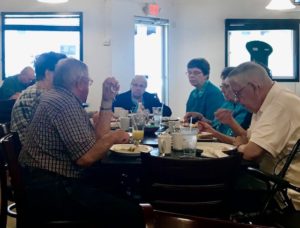 (Celebrating Selma’s 92nd birthday.
(Celebrating Selma’s 92nd birthday.
Breakfast at Friendly Corner, Laurel, Nebraska)
September 13, 2018 4 Comments
Route 20 report #1
It’s day 6 of the #insearchofamerica #route20 #carcamping #coasttocoast #roadtrip (because, you know, Instagram).
We’re in Thermopolis, Wyoming, where we stopped to soak our tent-sleeping bodies in the largest natural hot springs in the world (who knew) and soak our camping-grimy clothes in the Thermopolis Wishy Washy Washateria.
There is too much to write about. When you have a different, vastly different, experiences every day, when the landscape changes hour by hour, when random conversations with locals open your eyes to our similarities and our differences, when you spend every night in a different spot, when the thrum of the two-lane road gives you ample time to think…there is too much to write about.
But here are a few thoughts and a few images from the road.
People out here are not “pro” guns the way others (like me) are “anti” guns. It doesn’t appear to be an “issue” one reasons through. I don’t mean people out here are not thoughtful. I mean guns are so embedded in the culture, so much a part of daily life that you’re not “for” them. They just are. Like a pair of shoes. Like a hairbrush. The issue comes in when we attempt to (in ANY way) regulate what they take for granted. A few days ago, outside Nyassa, Idaho, we passed a huge billboard on route 20: “Any regulation takes away freedom.”
You talk to a person in one of these one-street towns along the way, maybe she’s the waitress serving you eggs and sausage at the Abacadabra Café or the guy giving you advice about which washing machines are the best at the Thermopolis Wishy Washy Washateria, and you ask them: “What do you love about this place? Why do you live here?” And they look at you uncomprehendingly. “My family is here,” they say. It’s that simple. Ask someone in Portland, Oregon the same question.
And just one more thing: The only Starbucks in Cody, Wyoming is in an Albertson’s. We stopped there. The soft-bodied, super-friendly woman behind the counter took our order. “Okay,” she said. “We’ll have that for you in…” she looked over at the woman working the espresso machine. “In a while.” She laughed. And it did take a while. And that was perfectly fine. Because it gave us a chance to have an impromptu conversation with a woman whose daughter runs the Meeteesi Labor Day celebration. Which we really should see. Because it’s really something.
September 4, 2018 6 Comments

